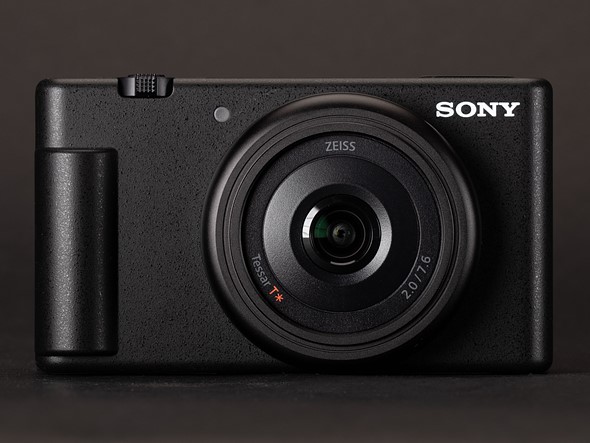19.49.39 Sony ZV-1F review | ||||||||||||||||||||||||||||||||||||||||||||||||||||||||||||||||||||||||||
Key specifications
The ZV-1F will be available from late October at a recommended price of $499. This is $300 less than the launch price of the existing ZV-1 model. Jump to: What it is? | How it compares | Review | Conclusion Scoring | Specifications | Press release What it is?
The ZV-1F is the company's second vlogging camera to be built around a Type 1 sensor but uses a wide-angle, 20mm equivalent, prime lens rather than the 24-70mm equiv zoom on the ZV-1. Despite the significantly lower price, the ZV-1F can shoot 4K video at up to 30p using the full width of its sensor.
This combination of a wide lens and full-width readout allows it to deliver a usefully wide angle-of-view, even with digital image stabilization engaged (imposing a 1.23x crop and giving an approximately 25mm equivalent field of view).
A combination of cropping and Sony's 'super resolution' upsampling allows the camera to offer a 2x 'zoom' despite the fixed lens. The camera's 5.5K sensor means that anything beyond 1.4x zoom must be taken from an area smaller than 4K and upscaled, so you're limited to '1.5x zoom' in 4K mode. The ZV-1F includes Sony's 'Product Showcase' AF mode that uses face detection but gives priority to things held up close to the camera. Interestingly, though, the ZV-1F does not have on-sensor phase detection, so has no inherent distance awareness.
Compact cameras have become pretty rare, but we suspect there'll be some photographers who are intrigued by the idea of a small, ultra-wide prime camera with a comparatively large sensor. The first thing worth knowing is that the ZV-1F cannot shoot Raw files: it's JPEG or movie only. There's also no built-in flash and no hotshoe in which to mount one. The camera does offer full PASM shooting modes, though, so you can take control and shoot stills if you wish.
How it comparesThe only real peer to the ZV-1F is the original, zoom lens ZV-1 and, of course, the higher-end smartphones that are a popular choice for vlogging.
ReviewSince the ZV-1F is designed as a vlogging camera, we felt it made more sense to present the bulk of our review in vlog form. Take it away, Chris: Conclusion
The ZV-1F needs to perform a difficult balancing act. As a lower-priced alternative to the ZV-1, some features need to be sacrificed (ND filter, Raw photography) or scaled back (focal range, autofocus performance). The trouble is, with every cost-cutting measure, the benefits of using a dedicated camera over a modern smartphone also diminish. Yes, the ZV-1F video quality when vlogging will be superior to your smartphone’s selfie camera, but you will also lose features like 4K/60P, faster sensor readout and optical stabilization that most smartphones offer. Whether the ZV-1F makes sense for you will largely depend on how much you utilize the articulating screen for creative camera angles. Whether the ZV-1F makes sense for you will largely depend on how much you utilize the articulating screen for creative camera angles, and the clever ‘Product Showcase’ mode. These features alone will be worth the very reasonable price for many. The inclusion of Sony’s professional picture profiles and log video recording also mean the ZV-1F could be a great second or overhead camera that will color-match with a higher-end Sony camera. So, while we can definitely see some situations where the ZV-1F could be a smart choice, for the majority of those getting interested in vlogging and video production, we think it might be worth saving up a bit more for the Z-V1 or ZV-E10, both of which offer far more advantages over a modern smartphone. How about for stills?By Richard Butler As a stills camera the ZV-1F is an interesting proposition. It's not particularly intended as a primarily photographic device, but that doesn't mean it can't be used as one. Autofocus is pretty quick, even without phase detection, and its combination of a large sensor (by compact camera or smartphone standards) plus a relatively bright lens is an interesting one. Its image quality is good, but without the automatic combination of multiple shots used by high-end smartphones, it won't necessarily offer a significant increase in image quality over the likes of the latest iPhone, Pixel or Galaxy. And, perhaps to protect RX100 series sales, there's no option to shoot Raw to gain processing flexibility. So, it really comes down to the question of whether the ZV-1F offers a suitably superior photo-taking experience to justify the use of a separate device. We're not wholly convinced in this regard. With only a single, fiddly control dial on the back of the camera, the ZV-1F doesn't offer much beyond the touchscreen-based experience you'd get from a phone. The zoom rocker on the front isn't tremendously useful, given the fixed lens, so you end up all fingers and thumbs with a device that constantly reminds you that this isn't what it was built for. $500 for a pocketable, large sensor, ultra-wide camera might sound pretty cool, but be very aware you're not getting a cut-price 20mm equiv Ricoh GR. Read more https://www.dpreview.com/reviews/sony-zv-1f-review | ||||||||||||||||||||||||||||||||||||||||||||||||||||||||||||||||||||||||||
|
| ||||||||||||||||||||||||||||||||||||||||||||||||||||||||||||||||||||||||||
| Total comments: 0 | |





